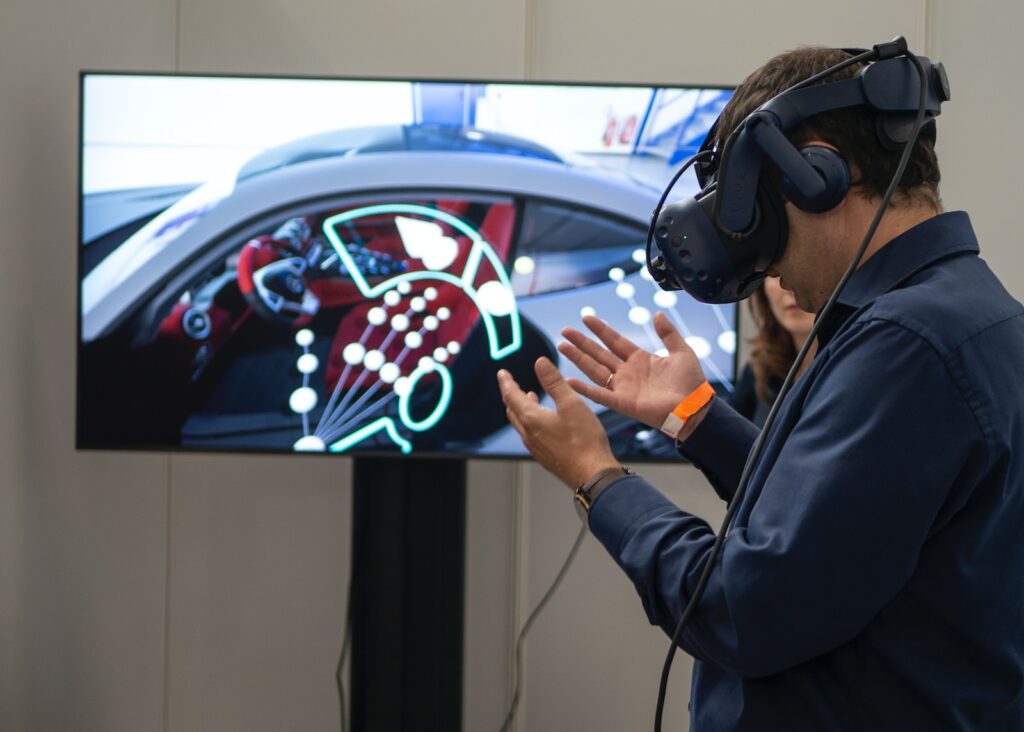Table of Contents
Introduction to Augmented Reality in the Medical Field
Augmented reality (AR) refers to a technology that overlays digital information or images onto real-world objects or environments. This cutting-edge technology has found its way into various industries, including medicine where it is being used for surgical planning and training. AR merges virtual elements with the physical world around us, thereby enhancing our perception of reality by adding context and interactivity.
The medical field primarily uses two types of AR: marker-based AR and marker-less AR. Marker-based AR involves using a camera or sensor to detect markers placed on an object, while marker-less AR does not require such markers but instead recognizes natural features within an environment.
With advanced augmented reality software, medical professionals can visualize complex three-dimensional structures like organs and bones in real-time from different angles and perspectives during surgery preparation. This is particularly helpful when preparing for complicated surgeries as it allows surgeons to anticipate potential complications before stepping into the operating room. Furthermore, this technology can assist in designing custom-fitted implants based on precise measurements taken via imaging technologies like CT scans.
The introduction of augmented reality has also revolutionized the training process for medical students and residents by providing them with a realistic representation of human anatomy without needing access to cadavers. Medical practitioners-in-training now have more opportunities than ever before to train safely under controlled circumstances that simulate actual clinical situations they may encounter later on in their careers – all through the aid of augmented reality simulation models which mimic specific patient conditions.
Benefits of Using Augmented Reality for Surgical Planning
Surgical planning is one of the most critical stages in any surgical procedure. Surgeons must have an accurate understanding of the patient’s anatomy to ensure that they can perform surgery safely and effectively. Traditionally, surgeons relied on medical imaging such as CT scans or MRI to plan procedures.
However, with advances in technology, augmented reality (AR) has emerged as a valuable tool for surgical planning. AR allows surgeons to visualise and manipulate three-dimensional virtual models of patient anatomy superimposed onto real-world imagery through a headset or tablet device.
- Improved accuracy: Perhaps the biggest advantage of using AR is that it provides surgeons with a highly accurate representation of patient anatomy. This level of detail helps them better understand complex structures while reducing the risks associated with traditional invasive methods.
- Better communication with patients: By showing patients their own anatomical structure in an AR environment, doctors are able to explain diagnoses and treatments more effectively. Patients are more engaged when they see what needs to be done and gain confidence in their surgeon’s expertise because they fully comprehend what will happen during surgery.
- Faster decision-making: In many cases, decisions need to be made rapidly during surgery due to unexpected complications arising from bodily variations that could not have been seen by conventional imaging techniques alone–which were often limited flat images without spatial depth information provided by medical imaging software packages. Augmented reality mitigates this risk offering realtime feedback about any kind issues while performing surgeries which allows better care delivery in less time.
- User-friendly interface: Augmented reality devices provide an intuitive, user-friendly interface that makes it easy for surgeons to interact with virtual models. AR headsets are lightweight and portable, allowing doctors to view images hands-free while operating without having to work around large machines.
- Lower costs: With augmented reality technology becoming more widespread in the medical field, the costs of implementing this type of surgical planning tool have decreased significantly. This means that more hospitals and clinics can benefit from using AR for surgical planning without breaking their budget.
- Better training opportunities: Schools or organizations which provide surgeon training programs can now use AR technology as a teaching aid. They prepare young medics by exposing them to realistic simulations of procedures with various difficulties levels like scars along past surgeries ahead time which helps them get used to real-life scenarios they may encounter over careers..
In summary, augmented reality holds great potential for transforming many aspects of surgery – particularly surgical planning. From improved accuracy and faster decision-making processes during complex operations or just showing patients what’s going on inside their bodies — there are many advantages associated with incorporating this advanced technology into medical practices worldwide!
How Does Augmented Reality Help with Surgical Training?
Augmented reality (AR) has proved to be an innovative tool that can enhance surgical training for medical professionals. The technology enables surgeons to visualize and interact with three-dimensional models of patient organs, allowing them to simulate procedures in a highly lifelike environment before operating on patients.
With AR, trainee surgeons can perform virtual operations numerous times without the risk of harming actual patients. This not only allows them to develop their motor skills and coordination but also helps them gain confidence essential for performing complex surgical procedures effectively.
The use of augmented reality in surgical training has vast benefits, such as enabling the surgeon-in-training to:
- Gather more experience: Trainees have greater access to real-world scenarios that they can learn from by observing the interactions between senior surgeons and challenging cases that they would not come across often.
- Increase accuracy: AR provides precise measurements during surgery preparation or operation. Surgical precision is especially important since it reduces complications during surgeries thus reducing morbidity rates among patients.a
- Become familiar with new equipment: Surgeons may practice using novel instruments through AR simulations before utilizing them in live situations.
- Analyze difficult diseases better: Surgical planning requires insight into disease patterns before starting surgery; this information is often derived from AI algorithms integrated into a specific software application used during these virtual simulations.
All of these advantages demonstrate how helpful augmented reality systems are in enabling physicians, particularly those just beginning their careers, become proficient enough at managing different clinical conditions safely while improving patient outcomes.”
Successful Case Studies Highlighting AR’s Role in Surgical Planning and Training
Augmented Reality technology has been implemented in various medical institutions to improve surgery planning and training procedures. Here are some successful case studies that highlight the benefits of using AR:
The University of Alabama at Birmingham Hospital
At the University of Alabama, a team used an AR system during craniofacial surgeries which allowed them to visualize virtual three-dimensional models of patients’ skulls. With this technology, surgeons were able to better understand their patient’s unique anatomical structure before entering into surgery.
Newcastle Surgical Training Centre
In a study conducted at Newcastle Surgical Training Centre in England, trainee surgeons used HoloLens AR headsets during surgical simulations. The results showed that trainees who received additional information through the headset had higher accuracy rates and performed more efficiently than those without it.
The Miami VA Medical Center
A team at Miami VA Medical Center utilized “Surgical Theater”, an AR software program that pre-visualizes operative plans for neurosurgeries. This software helps doctors be more precise with operation planning by providing interactive visualizations based on patient specific images taken from MRI’s or CT scans.
By utilizing these innovative technologies, medical professionals can maximize efficiency in surgical procedures while ensuring optimal outcomes for their patients.
Future Possibilities of Augmented Reality in Medicine
As the technology continues to evolve, it is safe to say that augmented reality will play an even more significant role in medicine than it already does. The possibilities are endless, and here are some of the currently explored future applications:
- Surgical Navigation: AR technology has already transformed surgical planning procedures for doctors around the globe. However, with time, researchers hope this technology can be used intraoperatively as well. By overlaying a patient’s anatomy onto their field of view during surgery, AR could provide real-time guidance on where to make incisions or place implants accurately.
- Patient Education: With augmented reality came interactive and immersive learning methods which no other tech was able to deliver before. In medical education alone its potential is evident where students have started using AR apps such as HoloAnatomy to study human anatomy interactively. This kind of approach could also benefit patients by helping them better understand certain conditions or treatments through visual representations.
- Treatment Planning: Augmented reality headsets equipped with specialty software can help clinicians “walk” around inside a virtual model created from images taken during diagnostic scans such as MRIs and CTs.This exciting new possibility would enable physicians and surgeons alike to plan complex surgeries much more effectively pre-operatively by determining optimal access points while avoiding sensitive areas like blood vessels or nerves.
- Mental Health Treatment: Mental health treatment maybe one area where AR might bring positive change too – recently there have been trials conducted exploring the use of VR/AR based therapies for various mental disorders such phobias or PTSD(more specifically) etc., treating patients virtually without exposing them directly(immersive virtual therapy) to the triggering situations could be very beneficial.
- Emergency Medicine: In emergency medical scenarios, every millisecond counts. With augmented reality tools at their disposal, paramedics or clinicians may have better ways of diagnosing and treating patients when there is not a moment to lose. Similarly, in remote areas where specialist care isn’t possible augmentation technology can help fill gaps by providing real-time consultations between doctors and first responders.
Augmented Reality has a hugely positive impact on healthcare already – but it looks like we’ve only scratched the surface so far. Time will tell just how much more effective medicine can become with AR innovations as they continue to be developed and integrated into daily workflows!
Challenges That Must Be Addressed In The Implementation Of AR Technology In Surgery
While the use of Augmented Reality (AR) technology in surgery has shown great promise, it also brings with it a unique set of challenges. For instance, one major challenge that needs to be addressed is patient privacy and safety concerns.
The use of AR technology may require sensitive patient data to be collected and used during surgical procedures. As such, healthcare professionals must ensure that patients’ personal information remains confidential throughout the procedure. Additionally, there is always a risk of medical errors occurring due to faulty or inaccurate augmented reality visualization systems.
This raises another critical issue – how can we guarantee the accuracy and reliability of such systems? It requires thorough testing before deploying them for clinical use. Moreover, software updates must be done regularly to avoid security breaches and glitches that could impact critical functions during surgery.
Another significant concern regarding the implementation of AR technology in surgeries involves accessibility issues; this includes limited access to tools or specialized devices needed for these kinds of procedures. Since most hospitals do not possess high-end equipment necessary for complex interventions using AR techniques on site permanently,
A lack of skilled personnel trained in handling advanced technologies like augmented reality poses yet another obstacle as they are scarce globally.
In conclusion, utilizing Augmented Reality (AR) technology undoubtedly provides immense potential benefits but equally faces several technical constraints increasing risks associated with its swift mode implementation without prior ethical guidelines development from stakeholders involved primarily involving surgeons themselves but also biomedical engineers could lead towards unwanted outcomes overshadowing advantages initially offered by such innovative methods revolutionizing surgical planning & training today’s next generation platforms offer us right now!




